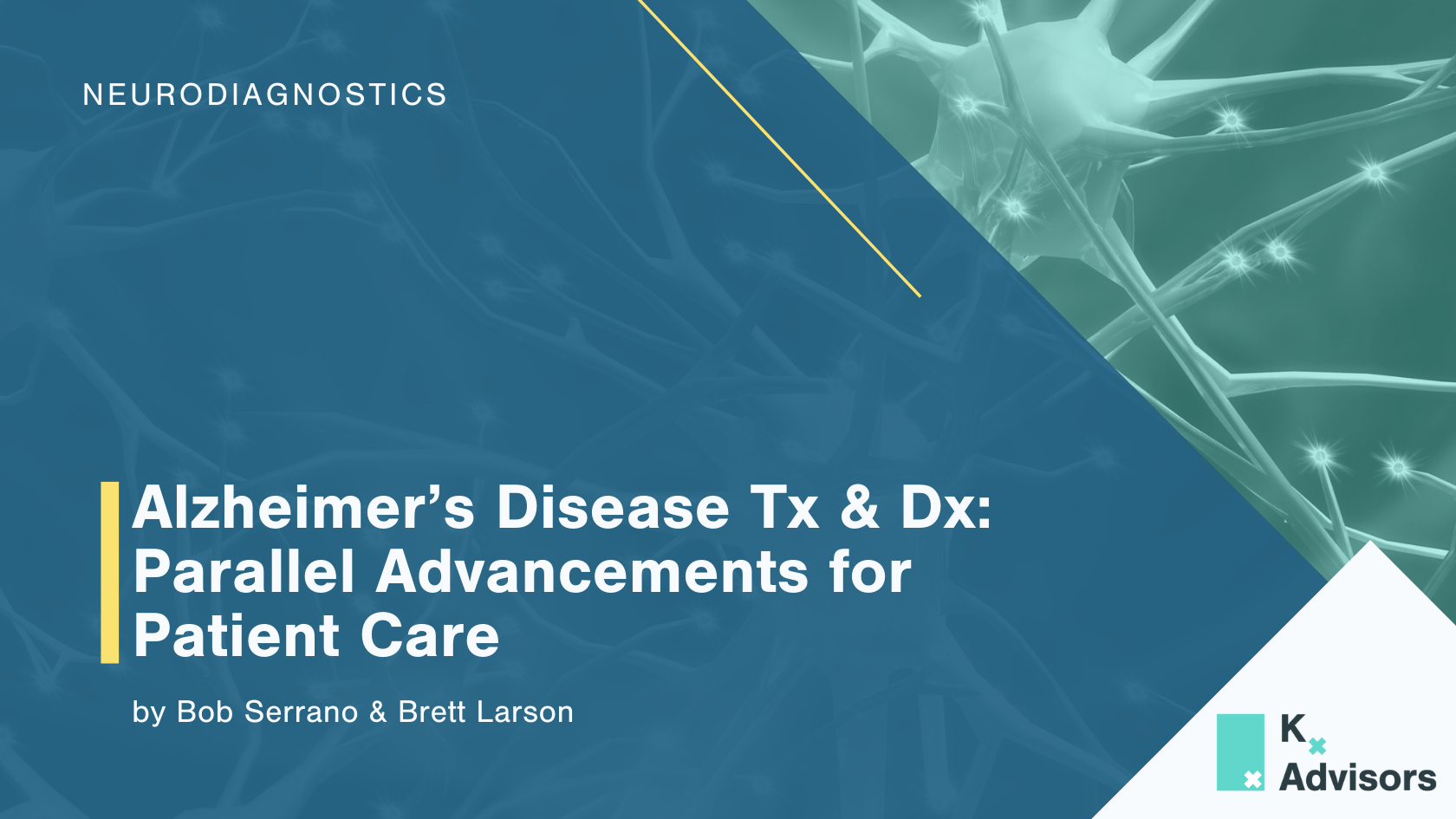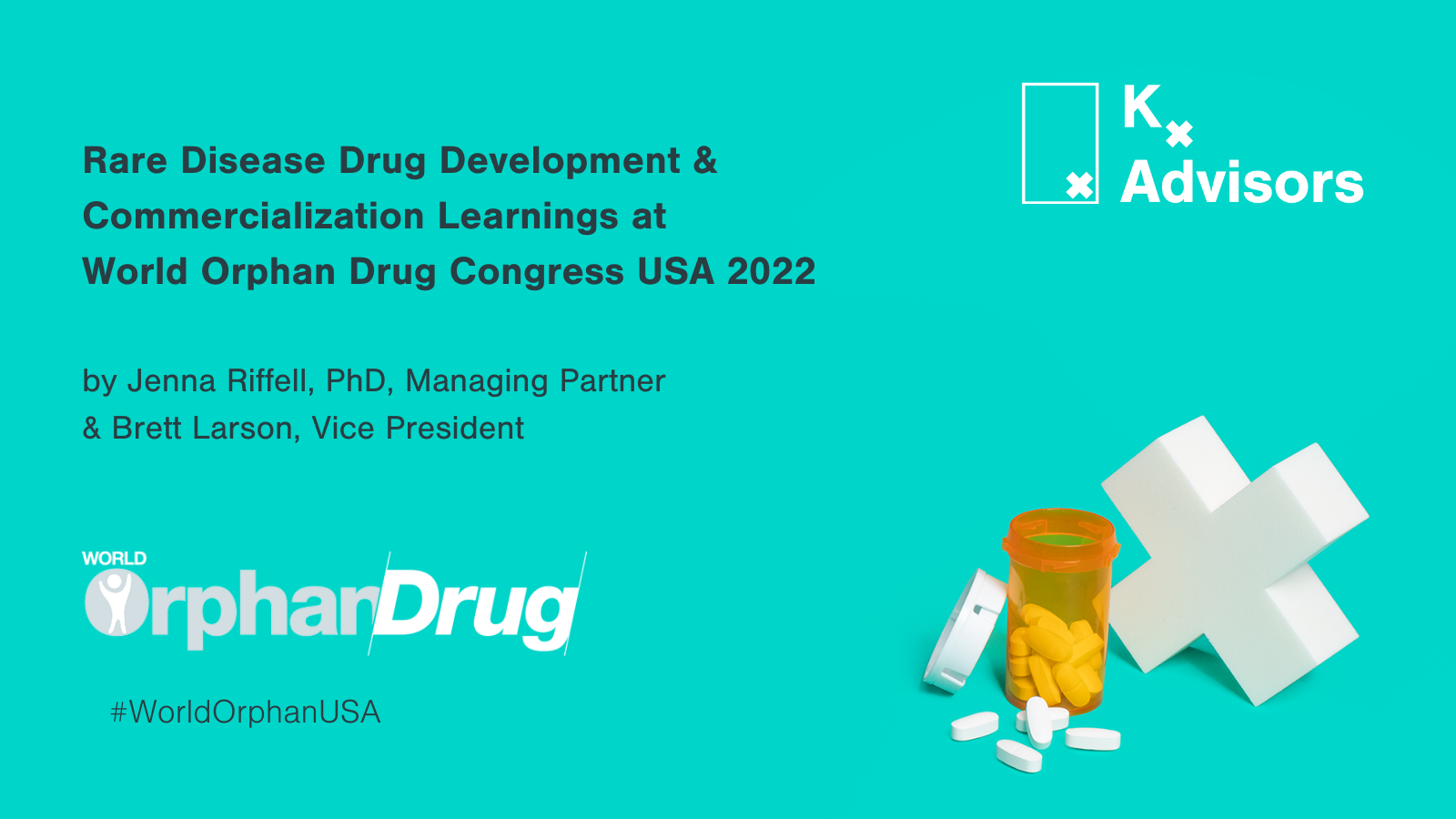Alzheimer’s Disease Therapeutics and Diagnostics – Parallel Advancements for Patient Care
2023 has already been a landmark year in Alzheimer’s disease (AD) therapeutics: lecanemab (Leqembi), co-developed by Biogen and Eisai, received FDA accelerated approval in January, and Phase 3 results for donanemab (Eli Lilly) are expected in 2Q23, with submission for FDA full approval shortly thereafter (accelerated approval was rejected in January). With the potential for widespread availability of novel treatments in the coming years, enabling timely, accurate diagnosis of Alzheimer’s disease should be front of mind for commercial strategy teams. Alzheimer’s complexity can make early diagnosis difficult, and misdiagnosis is common1. Fortunately, there is a burgeoning neurodiagnostics field aiming to offer clinicians and patients more certainty in their condition through a variety of CLIA-certified or FDA-approved diagnostic tests. The thoughtful selection and use of neurodiagnostics in clinical trials and the larger marketplace will be critical in the coming years to enable expanded access for Alzheimer’s Disease therapeutics.
Novel AD Treatments Necessitate Improved Diagnostics
Looking at the Alzheimer’s Disease (AD) therapeutic pipeline, there are over 30 disease-modifying therapies in late-stage clinical development2 with Eisai’s lecanemab (Leqembi) and Eli Lilly’s donanemab garnering the most attention. In their confirmatory phase 3 trials, both treatments included patients suffering from early symptomatic disease or mild cognitive impairment (MCI) due to AD and aim to measure an improvement from baseline in cognitive function tests using different metrics and brain amyloid plaque deposition using PET scans. Summarized in the table below, lecanemab relies on Clinical Dementia Rating scale Sum of Boxes (CDR-SB) as the primary outcome measure while donanemab utilizes the Integrated Alzheimer’s Disease Rating Scale (iADRS):
Testing Approaches for Diagnosing Alzheimer’s Disease
| Test Category | Strengths | Drawbacks |
|---|---|---|
| Cognitive, Functional, and Behavioral Tests: Evaluate an individual’s mental abilities to identify changes in cognitive function Notable examples: Clinical Dementia Rating scale Sum of Boxes (CDR-SB); Integrated Alzheimer’s Disease Rating Scale (iADRS) | Familiar and good track record Low cost and quick administration Able to detect disease progression | Relies on HCP consistency in application and interpretation; errors are common among PCPs Relies on heterogenous clinical symptoms; CFB tests alone lead to misdiagnosis and cannot detect pre-clinical AD |
| Structural Brain Imaging: Segments and measures volumes of key brain structures; used for the detection of AD biomarkers Notable examples: Volumetric Magnetic Resonance Imaging (vMRI); PET scan; CT scan | Well-established for AD diagnosis, particularly PET scans Provides an objective measure Differentiates AD from other forms of dementia (such as vascular dementia and frontotemporal) | High cost and large footprint scanning machines required Not suited/accessible to primary care settings False positives; brain changes may not be indicative of AD Patient experience; potential sedation risk to achieve needed stillness |
| Cerebrospinal Fluid (CSF) Tests: Detection of AD biomarkers in CSF samples, such as β-amyloid, t-tau, and p-tau Notable examples: Lumipulse® Aβ42/40 assay (Fujirebio); Elecsys CSF phospho-tau181/Aβ42 assay (Roche) | Accuracy improvements (when used alongside other tests) Routine use in specialist healthcare settings Differentiates from other forms of dementia (such as Lewy body and frontotemporal) | Invasive procedure required (lumbar puncture); risk of side effects and some patients are contraindicated (e.g., anticoagulants use) Limited accessibility in primary care settings Not validated in diverse populations |
| Blood Tests: Detection of AD biomarkers in blood samples, such as levels of β-amyloid, tau protein and neurofilament light (NfL) protein Notable examples: PrecivityAD® (C2N Diagnostics); Quest AD-Detect (Quest Diagnostics) | Low cost Easy to administer/minimally invasive Routine across relevant healthcare settings | Currently less accurate /definitive than brain imaging or CSF analysis Requires more sensitive measurement due to low biomarker concentrations Lower specificity in later stages of AD when biomarkers are more indicative of general neurodegeneration |
| Genetic Testing: Detection of genetic variants associated with an increased risk of developing AD Notable examples: APOE ε4 variant (for early- and late-onset AD); PSEN1, PSEN2 and amyloid precursor protein (APP) | Identifies risk of developing AD, supporting earlier diagnosis | Limited predictive power Limited use for diagnosis of late-onset AD; no strongly associated mutations Ethical considerations; potential for psychosocial impact of test results |
Both primary endpoints, CDR-SB and iADRS, diagnose behavioral symptoms rather than biomarker measurement in their scoring. CDR-SB is frequently chosen as an endpoint as it detects disease progression by assessing cognition and function in personal care, problem-solving, memory, and other functions; however, it has been criticized for its inconsistent reproducibility in detecting treatment differences. 5 On the other hand, iADRS is argued to reliably detect disease progression and treatment effects in participants across the spectrum of disease by measuring similar cognition and function categories through a composite score of ADAS-Cog-13 and ADCS-iADL.5 A point of concern is that payers may require biomarker data to supplement these cognitive tests to approve access to costly AD therapy and restrict access when inconsistencies arise. Forward-thinking therapeutic developers should consider now which sources of biomarker data will remove barriers to access to therapeutics and how best to validate this ability.
Breadth of Innovation in Diagnostics Development
Recently, diagnostics companies have collaborated with key players in AD therapeutics trials by measuring inclusion criteria and endpoint biomarkers. In November, C2N Diagnostics announced the PrecivityAD test’s use in the AHEAD trial, a lecanemab extension study, as part of the inclusion criteria of quantifying elevated brain amyloid.6 Specifically, PrecivityAD, a blood test, satisfies the requirement to show a plasma, cerebrospinal fluid (CSF), or positive PET result predictive of intermediate or elevated amyloid before screening. Neurodiagnostics contribute to endpoint measurements as well. When Eisai presented their ClarityAD results, all the target engagement and drug activity data from a panel of fluid biomarkers- including plasma pTau-181, GFAP and NfL – were from Quanterix Corporation’s ultrasensitive Simoa assay kits. 7 Overall, diagnostics are already useful at the clinical trial stage and may supplant less accessible and expensive gold-standard testing like amyloid PET in the future.
Outside clinical trials, the emerging neurodiagnostics landscape is rife with innovation, using various modalities testing for different biomarkers. Fujirebio’s Lumipulse Aβ42/40 and Roche’s Elecsys CSF phospho-tau181/Aβ42 assay both offer FDA approved Aβ42/40 measuring tests using cerebrospinal fluid (CSF) to assist clinicians in making diagnoses beyond clinical examination.8,9 This advance comes at the cost of the patient’s comfort due to the invasiveness of CSF collection. Quest Diagnostics and C2N Diagnostics address this through their CLIA-certified plasma blood tests, Quest-AD and PrecivityAD respectively, whose results approximate that of amyloid PET scan findings. Will we soon see a “Test and Treat” future in AD? Not so fast. Considerable work remains before widespread clinical adoption of plasma tests can occur.10 One major barrier is the lack of plasma test performance data in diverse patient populations with comorbidities like chronic kidney disease or a history of stroke that may boost AD biomarkers in the blood. Researchers also stress that CSF and plasma tests shouldn’t be used in cognitively healthy individuals since the disease has a long preclinical phase and may not manifest in the patient’s lifetime, causing undue distress and financial ramifications. All these companies face the current headwinds of defining and achieving their reimbursement strategy in an environment where therapeutic clinical utility is still evolving. The definition of coverage policies and diagnostic criteria by CMS and major commercial payers will drive the adoption and utilization of tests moving forward.
Future Challenges Facing AD Patients
It is unclear how many patients will receive the benefit of Leqembi and other anti-amyloid therapies. In April 2022, CMS effectively denied Medicare coverage of any anti-amyloid therapies, a decision they recently re-iterated after denying petitioning from the Alzheimer’s Association.11 Despite this, the Veteran’s Health Administration has determined it will cover access to Leqembi to veterans who fit the VHA’s criteria and the FDA label indication. In response to Aduhelm’s accelerated approval, CMS’s Chief Medical Officer left the door open to broad access if a therapeutic shows evidence of clinical benefit through the traditional full FDA approval process. 12 A decision on full approval for Leqembi is expected in July, preceded by an FDA Advisory Committee meeting scheduled for June 9th. Once a therapeutic overcomes this hurdle, questions about clinical utility for both a therapeutic and a diagnostic will be more settled and replaced with a simple one: what diagnostic tests can help accelerate access for an AD disease-modifying therapy?
In the near future, partnerships between diagnostics companies and drug developers can make a big difference for the millions of people grappling with the impact of dementia on their health and families. Early collaborations like the one between Eisai and C2N Diagnostics in the AHEAD study may mark the beginning of new and deeper partnerships between these two fields. New therapeutics will benefit from a robust diagnostics industry helping patients get an earlier diagnosis and diagnostics manufacturers will receive wider adoption and uptake. Future joint commercial partnerships can allow caregivers and physicians to test an individual and match them to the most appropriate treatment available.
How Kx can help
We at Kx are monitoring the Alzheimer’s Disease space evolution closely and see opportunities for commercial planning teams to meet the technology of the future through concrete, forward-looking steps today. To join us and discuss further, contact Brett at brett.larson@kxadvisors.com.
Thank you to Jean Santos for his contributions in the development of this piece.
References
- Gaugler JE, Ascher-Svanum H, Roth DL, Fafowora T, Siderowf A, Beach TG. Characteristics of patients misdiagnosed with alzheimer’s disease and their medication use: An analysis of the NACC-UDS database – BMC geriatrics. Characteristics of patients misdiagnosed with Alzheimer’s disease and their medication use: an analysis of the NACC-UDS database. https://bmcgeriatr.biomedcentral.com/articles/10.1186/1471-2318-13-137. Published December 19, 2013. Accessed February 2, 2023.
- Alzheimer’s Disease Therapeutics. https://www.alzforum.org/therapeutics/search?fda_statuses%5B%5D=851&target_types=&therapy_types=&conditions%5B%5D=145&keywords-entry=&keywords=. Accessed January 29, 2023.
- Commissioner Oof the. FDA grants accelerated approval for Alzheimer’s disease treatment. U.S. Food and Drug Administration. https://www.fda.gov/news-events/press-announcements/fda-grants-accelerated-approval-alzheimers-disease-treatment. Accessed January 29, 2023.
- Rogers MB. No accelerated approval for Donanemab. No Accelerated Approval for Donanemab. https://www.alzforum.org/news/research-news/no-accelerated-approval-donanemab. Accessed January 29, 2023.
- Wessels AM, Rentz DM, Case M, Lauzon S, Sims JR. Integrated alzheimer’s disease rating scale: Clinically meaningful change estimates. Alzheimer’s & Dementia: Translational Research & Clinical Interventions. 2022;8(1):197-210. doi:https://doi.org/10.1002/trc2.12312.
- Consortium ACT. New blood test to identify people at risk of developing Alzheimer’s symptoms will be used in clinical trial aiming to prevent memory loss. New Blood Test To Identify People At Risk Of Developing Alzheimer’s Symptoms Will Be Used In Clinical Trial Aiming To Prevent Memory Loss. https://www.prnewswire.com/news-releases/new-blood-test-to-identify-people-at-risk-of-developing-alzheimers-symptoms-will-be-used-in-clinical-trial-aiming-to-prevent-memory-loss-301422214.html. Published November 11, 2021. Accessed January 29, 2023.
- Quanterix’s Simoa® technology drives advances in Alzheimer’s disease research presented at 2022 clinical trials on Alzheimer’s disease (CTAD) conference. Quanterix’s Simoa Technology Drives Advances In Alzheimer’s Disease Research Presented At 2022 Clinical Trials On Alzheimer’s Disease (CTAD) Conference. https://www.quanterix.com/press-releases/quanterixs-simoa-technology-drives-advances-in-alzheimers-disease-research-presented-at-2022-clinical-trials-on-alzheimers-disease-ctad-conference/. Published December 6, 2022. Accessed January 29, 2023.
- FDA permits marketing for new test to improve diagnosis of alzheimer’s disease. FDA Permits Marketing for New Test to Improve Diagnosis of Alzheimer’s Disease. https://content.govdelivery.com/accounts/USFDA/bulletins/3165b47. Published May 4, 2022. Accessed January 29, 2023.
- Zinkovich C. Roche alzheimer’s Disease Cerebrospinal Fluid (CSF) assays receive FDA clearance, supporting more accurate and timely diagnosis. Roche Alzheimer’s disease Cerebrospinal Fluid (CSF) assays receive FDA clearance, supporting more accurate and timely diagnosis. https://diagnostics.roche.com/us/en/news-listing/2022/roche-alzheimers-disease-cerebrospinal-fluid-assays-receive-fda-clearance.html. Published December 8, 2022. Accessed January 29, 2023.
- Rogers MB. FDA approves Fujirebio’s CSF test for ad-quest diagnostic offers plasma test. FDA Approves Fujirebio’s CSF Test for AD—Quest Diagnostic Offers Plasma Test. https://www.alzforum.org/news/community-news/fda-approves-fujirebios-csf-test-ad-quest-diagnostic-offers-plasma-test. Published May 21, 2022. Accessed January 29, 2023.
- Fact sheet Medicare coverage policy for monoclonal antibodies directed against amyloid for the treatment of Alzheimer’s disease. Medicare Coverage Policy for Monoclonal Antibodies Directed Against Amyloid for the Treatment of Alzheimer’s Disease. https://www.cms.gov/newsroom/fact-sheets/medicare-coverage-policy-monoclonal-antibodies-directed-against-amyloid-treatment-alzheimers-disease. Published April 7, 2022. Accessed January 29, 2023.
- Press release CMS finalizes Medicare coverage policy for monoclonal antibodies directed against amyloid for the treatment of alzheimer’s disease. CMS Finalizes Medicare Coverage Policy for Monoclonal Antibodies Directed Against Amyloid for the Treatment of Alzheimer’s Disease. https://www.cms.gov/newsroom/press-releases/cms-finalizes-medicare-coverage-policy-monoclonal-antibodies-directed-against-amyloid-treatment. Published April 7, 2022. Accessed February 7, 2023.




